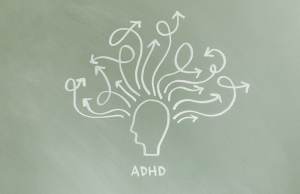This guide is for parents who are struggling to understand their child’s ADHD symptoms or diagnosis of ADHD, and for the adults who grew up believing that something was wrong with them – because their brains didn’t work like other people’s. The ADHD mind has its own rules. When you know those rules, you can better advocate for your child, or for yourself. You can stop setting up the ADHD mind for failure, and instead build a roadmap of solutions – founded on unconditional love, informed support, and acceptance.
We wanted to present some of the latest neurological research, as well as offer practical parenting tips that will help you manage the significant challenges ahead. But most importantly, we wanted to show you that being different doesn’t mean being defective.

What Is ADHD?
ADHD (attention deficit/hyperactivity disorder) is a lifelong condition that affects the nervous system and typically begins to manifest in childhood. ADHD used to be called “attention deficit disorder” (ADD), and before that “minimal brain dysfunction,” and before that “hyperkinetic disorder.”
Globally, ADHD affects 5.9% of children and 2.5% of adults. It’s more common in boys than girls, at a ratio of about 2:1. Symptoms can sometimes diminish, evolve, or even resolve in the course of maturation, which isn’t fully accomplished in the brain’s frontal lobes until age 35.
Three out of four kids with ADHD in the US receive treatment for it, improving their long-term outcomes. And symptoms can run the gamut from borderline to very mild to severe. People with ADHD symptoms are successful artists, executives, athletes, doctors, politicians, and more. There’s no limit to what the ADHD mind can do when it’s engaged. Its hyperfocus can be a superpower, not a handicap.
Some of the main things to know about ADHD include:
- ADHD affects brain networks, or cognitive pathways. It’s not an IQ issue; it’s an internal communication issue. Functional imaging from PET scans and fMRIs shows that the ADHD mind struggles with top-down control, the executive signals that tell us what to pay attention to, and when. The ADHD brain has been called an “interest-based nervous system,” meaning it’s hard for its neural networks to stay on task when something distracting comes along. Dr. Ned Hallowell likens it to having “a race car brain with bicycle brakes.”
- When thinking about ADHD, age and environment are vitally important. For example, you wouldn’t expect a toddler to function well in a highly structured grade-school classroom, and you shouldn’t expect an immature nervous system to be able to perform the same tasks as neurotypical white matter. Russell Barkley, PhD, states that the maturity of the ADHD brain lags roughly 30% behind a neurotypical brain in “executive age.”
- ADHD isn’t consistent. William Dodson, MD, states, “The hallmark of the ADHD nervous system is not attention deficit, but inconsistent attention.” Someone with ADHD can be incredibly focused – when their mind is stimulated and engaged.
- You can’t expect people with ADHD to fulfill their potential in the same ways as neurotypical people. This means that barking orders at someone with ADHD may only exacerbate their cognitive challenges.
- ADHD should not be someone’s defining characteristic. It’s a quirk of how their brain functions, and it’s important, but it’s not who they are.
- ADHD is dimensional, not categorical. This means that there’s a broad spectrum of functionality within the condition, and diagnosing ADHD isn’t a matter of looking at black and white biological markers, but rather at a wide, eclectic range of symptoms (more on those below).
- People with ADHD are often more vulnerable than neurotypical people. They’re at higher risk for developing other psychiatric conditions like depression, for occupational impairments at school and work, for social difficulties, and for low self-esteem. Which means that we must begin advocating for them from a young age.
- ADHD can be treated successfully with safe medications and behavioral therapy. These evidence-based interventions must be tailored to each individual and their goals, but decades of research show that they work.
What Does ADHD Do to a Person?
ADHD can cause a variety of symptoms that someone might experience. The most outwardly noticeable include the following:
- Difficulty focusing
- Difficulty concentrating
- Cutting people off when talking
- Restlessness
- Inability to sit still
- Irritability
ADHD is a sensory processing disorder, this means that it takes someone who has ADHD a bit longer to process stimuli and information received from their environment. This doesn’t mean they’re stupid, just that their brain uses more “battery life” (like on a cell phone) than others’ brains have to use to process information and stimuli and react in an appropriate way. There is also no intelligence difference between people who have ADHD and those who don’t.
What Are 3 Signs of ADHD?
There can be many different signs that indicate that someone might have ADHD. The most common three are as follows:
- Inattention: this can look like needing statements repeated, needing to hear questions multiple times, not being able to retain information just heard or learned, not being able to fully understand something due to an inability to focus on just one thing at one time.
- Restlessness: another common sign/symptom of ADHD is restlessness. This can look like a child “squirming” in their seat at school or needing to stand up frequently. In adulthood, restlessness can look like pacing, difficulty remaining still or seated for more than 15 minutes at a time, and can include tic-like behaviors such as: restless legs, constantly changing sitting positions and posture, or walking laps or pacing.
- Impulsivity: another big sign/symptom of ADHD is impulsivity. Not everyone that has impulsive tendencies has ADHD, but most people with ADHD will demonstrate a level of impulsivity. Impulsivity can look like but is not limited to the following: making quick decisions without consulting others, speaking before thinking (not having a “filter”), gambling, overspending money, etc.
Hello, we're here to help you
We provide award-winning mental health services nationwide, with flexible scheduling & insurance coverage. Start your journey this week.
What Are the Other Symptoms of ADHD?
In order for ADHD to be properly diagnosed, one must meet symptoms of inattention and/or hyperactive and impulsive behavior patterns that also contain 6 or more of the following symptoms below and have been present for at least 6 months (info quoted from the DSM 5):
The individual…:
- Fails to give close attention to details or make careless mistakes in schoolwork, at work, or with other activities.
- Has trouble holding attention on tasks or play activities.
- Doesn’t listen when spoken to directly.
- Doesn’t follow through with instructions and fails to finish schoolwork, chores, or duties in the workplace (e.g., loses focus, side-tracked).
- Has trouble organizing tasks and activities.
- Is reluctant to do tasks that require mental effort over a long period of time (such as schoolwork or homework).
- Loses things necessary for tasks and activities (e.g. school materials, pencils, books, tools, wallets, keys, paperwork, eyeglasses, mobile telephones).
- Becomes easily distracted.
- Is forgetful in daily activities.
How Can I Tell if I Have ADHD?
The only true way to see if you have ADHD is to consult with a professional. However, you can tell if you would need to consult a mental health professional regarding these symptoms if they are causing significant impairment in your daily life and cannot be explained by other disorders or current life stressors.
For example, if you have difficulty managing time at work and it’s causing you to miss significant work deadlines, that would be an indication that you might have ADHD. If you feel unable to focus or you start and fail to complete tasks, this could be another indicator.
Is ADHD on the Autism Spectrum?
ADHD is not on the autism spectrum, and this is a common point of confusion for many people. ADHD and autism spectrum do live under the same family of “disorders” (neurodevelopmental disorders), however.
Neurodevelopmental disorders are those that typically occur in early developmental stages of a child’s life and can cause impairment/disruption to that child’s specific function at that stage.
ADHD and autism are also both classified as being under the category of neurodivergence. This term means that there are certain structural and functional components of the brains of those that have these disorders that cause them to look and function differently (not deficiently) than others.
Is ADHD Considered to Be a Disability?
ADHD is considered a disability under the Americans with Disability Act. This means that people who have ADHD have significant rights in the workplace and public settings that are legally protected.
This can look like employers/schools/other public institutions being required to provide appropriate accommodations for individuals with ADHD to enable them to do their jobs efficiently and effectively. This recognition often means that someone can qualify for disability if their ADHD is interfering significantly enough to prevent them from working or making a living.
What Not to Say to Someone with ADHD
Do not call someone with ADHD “stupid” or “dumb” or “incompetent” because they might need 5 more minutes to problem-solve. While ADHD is becoming more popularly-understood, a lot of people with ADHD are subject to verbal harassment from their peers more than others.
Other phrases to avoid saying to people with ADHD include:
- “Just write it down in a planner.”
- “Why can’t you do anything right?”
- “Why is this taking you so long?”
- “Just make a decision.”
People with ADHD have a significantly more difficult time processing information, so it might take them longer to answer a question or figure out a solution. Attempting to rush them, scold them, or otherwise chastise them will not help them accomplish a task with greater speed.
What Are the Signs of ADHD in a Girl?
The signs of ADHD in those assigned female at birth are very similar to those of people who are assigned male at birth. Many times, the symptoms of ADHD in women tend to be overlooked due to societal conditioning and pressures.
For example, girls might not demonstrate restlessness and hyperactivity in the same way toddler boys do, due to a social conditioning in American culture that girls are to be “quiet and obedient”. Often, girls tend to be able to mask symptoms of inattention more efficiently than boys, due to cultural expectations and pressures as well as perceptions of responsible adults such as teachers and parents.
Why Is ADHD So Common in the US?
According to the World Federation of ADHD, ADHD is neither a new disorder, nor an American disorder. Descriptions of ADHD symptoms in scientific literature go back to 1775. And the condition is found throughout the world at similar rates.
But ADHD is more likely to be diagnosed now due to increased awareness in clinicians. Which means that ADHD is more recognized, not more prolific. Using the same objective, standardized criteria for ADHD diagnosis, experts cite the same prevalence across the globe.
Some cultures, however, still stigmatize ADHD more than others. It’s also worth noting that Black youth in the US have an ADHD prevalence rate of 14.5% versus the collective 5.9%, likely due to misdiagnosis and lack of culturally appropriate care.
Is ADHD a Learning Disorder?
ADHD is more of a self-regulation disorder than a learning disorder, though it can cause learning challenges. ADHD and learning disorders/disabilities have a 45% comorbidity rate (when both conditions are present at the same time).
The DSM-5 describes three subtypes of specific learning disorder:
- Dyslexia (reading)
- Dysgraphia (writing)
- Dyscalculia (math)
In the US, the Individuals with Disabilities Education Act (IDEA) defines a specific learning disability (SLD) as “a disorder in one or more of the basic psychological processes involved in understanding or in using language, spoken or written, that may manifest itself in the imperfect ability to listen, think, speak, read, write, spell, or to do mathematical calculations, including conditions such as perceptual disabilities, brain injury, minimal brain dysfunction, dyslexia, and developmental aphasia.”
In American classrooms, children with SLDs and children with ADHD can be given special services and accommodations through individualized education programs (IEPs) and 504 plans. Through IEPs, parents and teachers can align about the best ways to help children succeed at school, whether that be through letting them sit on a balance ball rather than a chair when they’re at their desk, or giving them extra time for exams.
ADHD and Neurodiversity
Neurodiversity, short for neurological diversity, is a term used to describe natural variations in the human brain. ADHD, autism spectrum disorder (ASD), and dyspraxia (developmental coordination disorder, or DCD) are all considered neurodiverse/neurodivergent conditions.
Neurodiversity advocates believe that these conditions shouldn’t be pathologized as impairments or dysfunctions. Instead, we should focus on personal strengths (strength-based approach) and find ways to help neurodiverse people accomplish their goals.
A neurotypical person (or NT) is wired to:
- Interact successfully with peers
- Talk without major speech delays
- Tolerate change
- Not become overwhelmed by stimuli
- Regulate emotions
- Sustain attention
Someone with ADHD probably can’t do all those things consistently. But in a neurodiversity framework, you don’t have to be neurotypical to achieve well-being. Neurominorities have a sprawling range of abilities. And when they suffer, it’s not because anything is inherently wrong with them, but because their environment is a mismatch for their strengths and capacities.
What Causes ADHD?
Researchers are getting closer and closer to uncovering the precise causes of ADHD, but there’s still plenty that we don’t know. The ADHD origin story that everyone seems to agree on is “epigenetics.” Epigenetics is the term used to describe complex interactions between someone’s genes and their environment.
ADHD has a significant polygenetic component, meaning the disorder is highly heritable (70-90%), but without one specific genetic marker. “ADHD genes” need to be triggered by features in someone’s pre- and postnatal environments. In some cases ADHD can also be caused by genetic mutations.
Currently, researchers have identified a few complex environmental factors that seem to influence the onset of ADHD:
- Low birth weight or premature birth
- Maternal smoking during pregnancy
- Maternal use of acetaminophen (Tylenol) during pregnancy
- Early childhood exposure to lead or pesticides
- Brain injury
- Maternal autoimmune disorders like type 1 diabetes, ulcerative colitis, and psoriasis
- Maternal obesity
- Maternal high blood pressure
- Grandparent exposure to specific pollutants
- Psychosocial adversities
- Prenatal exposure to alcohol
It’s important to remember that ADHD is no one’s fault. What parent can predict how their unique genome will interact with infinite environmental factors? All you can do is love and support the child you were given.
ADHD Differential Diagnoses and Co-Occurring Disorders
A 2016 parent survey from the Centers for Disease Control (CDC) determined that 6 in 10 children with ADHD had at least one additional mental disorder. In adults, it’s more like 8 in 10. When one diagnosis overlaps with another diagnosis, we call those conditions “comorbid.” And ADHD has one of the highest comorbidity rates of any psychiatric disorder.
According to the DSM-5, ADHD often overlaps with externalizing disorders. These disorders include oppositional defiant disorder (ODD) and conduct disorder (CD), both characterized by problematic behaviors. Adults with ADHD are sometimes diagnosed with borderline personality disorder (BPD) and antisocial personality disorder (ASPD), both characterized by emotional instability and difficulty in top-down regulation.
Other mental disorders associated with ADHD include the following:
- Learning and language disabilities
- Tic disorders and Tourette’s syndrome
- Bipolar disorder
- Generalized anxiety disorder (GAD)
- Major depression
- Substance use disorder
- Obsessive compulsive disorder (OCD)
- Sensory processing disorder (SPD)
- Binge eating disorder
- Post-traumatic stress disorder (PTSD)
Some of these comorbid conditions may share underlying mechanisms, based in cortical wiring, motor/coordination difficulties, or emotional dysregulation. Other mental health issues, like low self-esteem, may be secondary conditions brought on by the ADHD experience. In any event, can make it harder to diagnose ADHD accurately, and can complicate treatment.
What Is an ADHD Person Like? How Does ADHD Affect Functioning?
Many experts conceptualize ADHD as an executive function disorder affecting a number of cognitive and emotional domains, sometimes categorized as “hot” and “cold” pathways.
Those domains are the following:
- Inhibition. Inhibition refers to someone’s ability to control one’s automatic responses. People with ADHD might have poor internal supervision, causing trouble with impulse control.
- Memory. The ADHD brain shows some impairments in working memory, which is related to executive function. If you can’t keep several things in your mind at once, then it can be harder to perform mental operations and make decisions. You can’t remember what you were supposed to be doing.
- Arousal. The ADHD brain might be hyperactive and sensation seeking due to “an unstable regulation of brain arousal.”
- Emotions. People with ADHD might become “flooded” with emotions. They’re also vulnerable to rejection sensitive dysphoria (RSD).
- Set shifting. Set shifting, or cognitive switching, involves behavioral flexibility–the ability to move between mental states. This flexibility can be impaired in ADHD.
- Motivation. People with ADHD may struggle with goal-directed behaviors. The neurotransmitter dopamine is intensely involved in motivation, and the ADHD brain has lower levels of dopamine. An individual with ADHD might also have a hard time conceptualizing long-term goals and planning accordingly.
- Temporal processing. The ADHD brain has issues with motor timing, time estimation, and temporal foresight. Someone with ADHD might also experience delay aversion, a sensitivity to delays prior to rewards or reinforcement. Immediate rewards are valued more than future rewards. This all relates to a different experience of time. In fact, ADHD has been called “time blindness,” with the condition creating a “nearsightedness to time.”
- Attention. The ADHD brain has trouble sustaining attention, especially when it comes to routine, boring tasks. Symptoms and impairments can come and go throughout the day.
Another thing to highlight about the ADHD brain is that it’s often caught in the default mode network (DMN), the brain process responsible for daydreaming, mind wandering, and even ruminating. But if the ADHD brain gets super engaged in something task-positive that requires conscious attention, the DMN deactivates.
Are There Any Benefits to Having ADHD?
Everyone with ADHD should know that their condition can be an asset. It’s especially helpful to kids to be given a positive framework in which to see themselves and their ADHD brains. Parents and caregivers can help children find a metaphor that feels good to them. For example, having a neurodevelopmental disorder is boring, but having a race car brain is awesome! Especially when you can help write the owner’s manual.
People with ADHD can be incredibly creative, especially when they find an outlet that really engages them. They can be great problem-solvers. They can be hyper-focused and energetic, bright and clever, spontaneous and adaptable.
Everyone who has ADHD is unique, with their own personal strengths that aren’t always traditionally valued in society. Parents of kids with ADHD can help their children find those strengths – and amplify them.
How Does ADHD Present Across the Lifespan?
ADHD is typically a lifelong disorder, meaning it affects both kids and adults. But its symptoms can change drastically over the course of a lifetime. Some people even go into complete remission. Longitudinal studies show that 40-60% of children with ADHD will experience partial remission. They might be less impulsive or hyperactive, for example, but still have attention issues. Only 15% of children with ADHD will still meet all diagnostic criteria as adults.
So how does ADHD look across the lifespan? We’ll break it down in the sections below.
ADHD in Children
A neurotypical child’s development follows a predictable pattern, exhibiting age-appropriate skills and behaviors, on a steady course year after year. But a child with ADHD may struggle to regulate their thoughts, feelings, and impulses long after their peers have learned to exercise top-down control.
This is because the ADHD brain does not mature in the same way, at the same rate, as a neurotypical brain. And in fact, research shows that kids who are young for their class get diagnosed with ADHD more often. Because it’s easy to confuse normal childhood immaturity with ADHD symptoms. An accurate diagnosis requires a mental health professional.
Their different wiring makes kids with ADHD more prone to disruptive behavior, excessive talking, fidgeting, emotional ups and downs, etc.–all the things that necessitate turning a good parent into a great parent. Because ADHD kids are challenging! But they’re also amazing. To thrive, they need supportive environments, and adults who are committed to looking out for their welfare.
How Do You Discipline a Child with ADHD? And Other Parenting Tips
Because kids with ADHD can have a hitch in their giddyup when it comes to motivation, parents, teachers, and other caregivers need to maximize their engagement in the task at hand. Get their brain firing on all cylinders. Redirect them. Give them immediate, positive reinforcement as they make incremental progress.
Parents can help kids with ADHD by freeing up their working memory. This is done by building predictable routines, by putting rules and processes on paper so children don’t have to remember all the steps, and by working with them in the moment rather than in the future–expecting them to have neurotypical foresight or hindsight. Because kids with ADHD have trouble with temporal processing, you can give them external visual aids like timers to help them keep track of time.
When it comes to discipline, parents must remember that for kids with ADHD, a carrot works better than a stick. In the ADHD brain, anticipation of a short-term reward generates dopamine, helping with operational thinking and self-regulation. Both positive and negative consequences need to be more immediate and frequent than with neurotypical kids. Essentially, you need to understand how your child’s brain works so you can help teach them, not punish them.
ADHD in Teens
Child psychology experts know that the adolescent and teenage years are an intense time. These years are packed with emerging sexuality, boundary-testing, academic challenges, peer pressure, first loves, and much more. And ADHD traits can make this intense time even more fraught. Teens with ADHD might engage in more risky and sensation-seeking behaviors. When they turn 16, their executive age could be years lower, and so it might be wise to delay their driver’s license until they can prove that they’ll be safe and attentive on the road.
ADHD in Adults
Academic or career success for an adult with ADHD might look a little different. Adults with ADHD have to perform in more complex environments than kids. They might have to find coping mechanisms to maintain their attention or prioritize tasks at work. They might not meet their deadlines. At home, adults with ADHD might procrastinate on paying bills or taxes. They may get into debt. They may have conflicts with their friends or family members because they’re always late. They might feel more sensitive to their spouse’s criticisms because they were criticized so much growing up. And they might have their own kids, who also have ADHD.
That being said, an adult with ADHD might achieve phenomenal success in a career that requires high levels of energy and multi-tasking. And their intimate understanding of how the ADHD brain works can make them more compassionate toward their own kids who may struggle with symptoms.
Even if an individual wasn’t diagnosed with ADHD as a child, it’s never too late to get help for the disorder.
ADHD in Women vs. ADHD in Men
Data from the CDC shows that boys are far more likely to be diagnosed with ADHD than their girl counterparts. But between 2003 and 2015, the number of women aged 15-44 who filled a prescription for an ADHD medication increased 344%.
Adult women with ADHD are often misdiagnosed with mood disorders. This is because ADHD can cause heightened emotionality. And other interesting things show up in research, like a study that showed women with higher levels of baseline irritability were likely to have more hyperactive and impulsive symptoms of ADHD after 18 months. This wasn’t the case for men.
What Are the Best Treatments for ADHD?
There are countless ways to alleviate the symptoms of ADHD, but experts tend to agree that the most effective ADHD treatment is a combination of medication and multimodal therapy. (Though the first-line treatment for kids under 5 with ADHD is therapy, not medication.)
The first step in ADHD treatment is planning. What are your or your child’s needs? More success at school? Increased productivity? Fewer behavioral issues and disruptions? Higher confidence? Better social skills? All your interventions should be person-centered and strength-based. They should also “respect and enhance those things that bring happiness and joy.” So think about your or your child’s goals, and go from there.
ADHD Therapy
We’ll cover ADHD medications at more length below, but let’s start with multimodal therapy. The National Institutes of Health (NIH) lists seven types of ADHD therapy and psychosocial interventions:
- Behavioral therapy
- Cognitive behavioral therapy (CBT)
- Family therapy and marital therapy
- Parenting skills training (behavioral parent management training)
- Specific behavioral classroom management interventions and/or academic accommodations
- Stress management techniques
- Support groups
People have found success with these additional non-pharmacological ADHD supports as well:
- Psychoeducation
- Supplements
- Healthy diets for healthy neurotransmitters
- Exercise
- Social and emotional learning (SEL)–social skills training
- Balance training
- Mindfulness meditation
- Computer-based cognitive training
- Neurofeedback
- Body-doubling
- ADHD apps and timers
- Fidget devices
Everyone with ADHD can write their own manual. But what definitely doesn’t work to ease ADHD symptoms?
- Punishment
- Shame and humiliation
- Neurotypical self-control strategies
A Breakdown of ADHD Medications: Benefits and Side Effects
Doctors who specialize in ADHD treatment typically recommend that people respect medication, but not fear it. There are two types of ADHD medication:
- Stimulants: methylphenidate and amphetamine
- Non-stimulants: atomoxetine, extended release guanfacine, and extended release clonidine
While working closely with a physician or psychiatrist, it may take some trial and error to get the right prescription and dosage of ADHD medication. Until you find the ideal formulation, possible side effects may include sleep issues, abdominal pain, and changes in appetite. Some medications are also associated with small delays in height gains in children. Too much medication may cause “Zombie syndrome” or “Starbuck’s syndrome.”
Though ADHD medications are proven to be safe and effective for people with the disorder, controversy still stems from overprescription and misuse of stimulant medication. Drug “shopping” and drug diversion is particularly problematic among college students.













